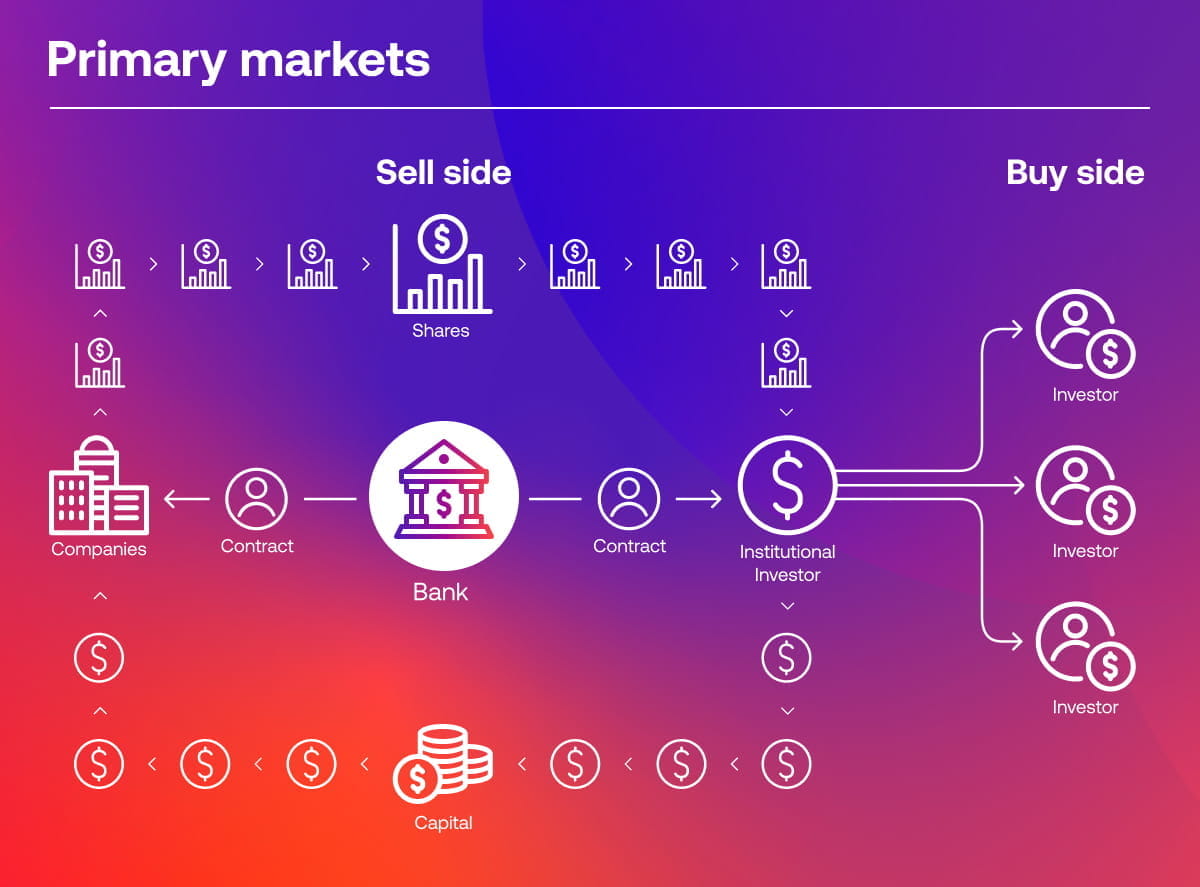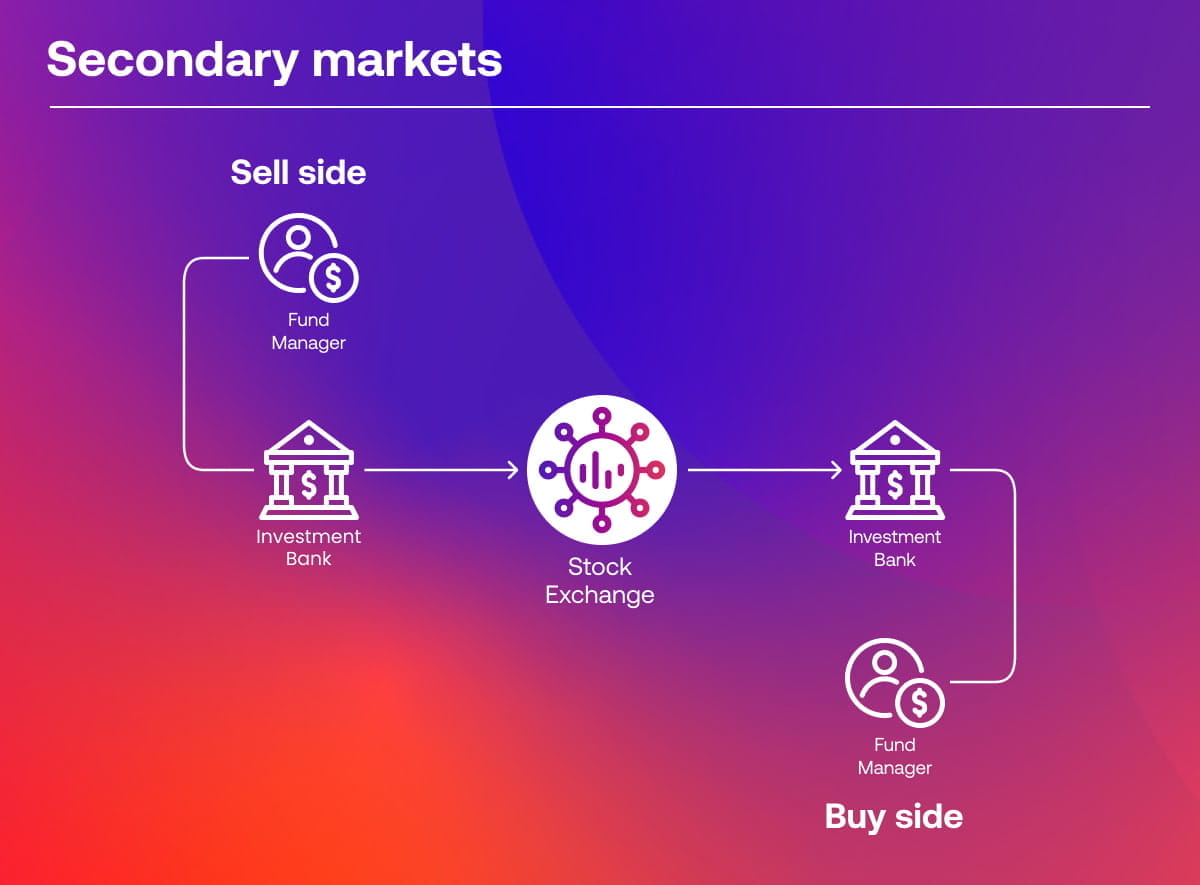What is the stock market?
The stock market is a public venue for the buying and selling of listed company shares and exchange traded funds (ETFs). It’s not a single market, but rather a network of stock exchanges around the world. Famous examples of stock exchanges include the New York Stock Exchange (NYSE), London Stock Exchange (LSE) and the NASDAQ.
A nation’s stock market is widely used as a benchmark for its economic health. Analysts use indices to track the performance of a specific group of stocks on an exchange. For example, the FTSE 100 represents the performance of the top 100 companies on the LSE by market capitalisation.
Get the most recent stock market news.
How does the stock market work?
The stock market works in by enabling buyers and sellers to negotiate their own prices for assets in a regulated forum. Buyers enter bids for shares in a company and sellers issue an ask price for their assets. Once a bid price equals the ask, a trade occurs.
Historically, stock markets were physical locations known as pits. However, most trades now take place via electronic trading platforms, which display the best bid and ask prices available at the current moment.
The difference between buy and sell prices is called the bid-ask spread. A narrow bid-ask spread indicates liquidity in the market, while a wider bid-ask spread indicates low trader activity. When looking to invest or trade shares
Only shares of publicly-traded companies are available to trade on the stock market. So, before buyers and sellers can trade or invest, a private company must first release its shares into the market – this is known as a primary market. Once the shares have been sold by the company, they’re then free to be traded between market participants, in what’s known as the secondary market.
What is a primary stock market?
The primary market is where shares are listed onto a stock exchange by a private company. For the firm, the purpose of any primary market is to raise capital for expansion and strategic operations. For an investor or trader, a primary market gives them the opportunity to get in on the ground floor of a company and take advantage of any growth the firm might experience.
Types of primary markets include:
- Initial public offerings (IPOs). These are the first opportunity investors will have to buy shares of a private company. The process is underwritten by an investment bank who will issue shares – usually only to institutional investors – at a set a price. Once the shares are listed, the company becomes a publicly-traded firm
- Rights issues or placings. These are the process by which an already public company lists additional shares onto the market to raise further funds from the public. The offering is made to the most appropriate investors – whether they are existing shareholders or not
The equity generated by the sale of stock in a primary market goes to the issuer and the bank receives a fee for facilitating the sale.

What is a secondary stock market?
The secondary market is where existing shares are traded among investors. Once a company’s stock has been sold in the primary market, the buyers are free to exchange them with other market participants and negotiate prices between themselves.
The company will not receive any money from the secondary market, as any capital generated from the stock will go to the investor who is selling their holding. Investment banks and brokers act as intermediaries for the transaction, as most stock exchanges don’t allow individual investors to directly trade into their order books.
There is no limit to how many times a share can trade hands in the secondary market.

What moves the price of stocks?
Stock prices are driven by the supply and demand for a company’s shares. When the demand for shares rise and outstrips the supply in the market – caused by a higher volume of – prices will likely rise. When supply increases beyond demand – due to a higher number of sellers – it can depress a share’s value.
While each individual stock will have its own trajectory and be moved by unique fundamental factors, the stock market does broadly move together as a result of news, market sentiment and macroeconomic data releases. Let’s look at each factor in more detail.
- Fundamentals – these are the characteristics of a company and its financial data that are needed to understand its overall health. Many investors use earnings releases and a company’s balance sheet to identify which of its fundamentals will impact their return, such as earnings per share (EPS) and price-to-earnings (P/E) ratios. If a company announces strong fundamentals – revenue, profits, sales and so on – then these metrics will rise, and the company’s stock will be more appealing to investors
- News and events can influence buying and selling decisions. Negative company news, earnings reports, political uncertainty and natural disasters will likely create selling pressure in the market, while positive news reinforces bullish sentiment
- Macroeconomic factors such as inflation, interest rates and economic data releases will all influence the outlook for individual companies and the stock market in general. If the economic outlook is poor, investment often declines and share prices fall
- Market sentiment refers to the general opinion on a stock or the stock market. These prevailing attitudes can arise based on a variety of factors – including fundamentals, news and macroeconomic data – but can also be formed based on popular opinion and rumours
How to invest in the stock market
There are two different ways to take advantage of the stock market: investing and trading. When you invest in the stock market, you’ll pay the full value of a share upfront, taking ownership of the asset and profiting if the market rises or dividends are paid.
However, if you trade the stock market instead – for example, by using Spread Bets or CFDs – you’ll be able to profit from rising and falling share prices. When you trade shares, you’re speculating on the underlying stock without taking ownership of the asset.
Learn how to trade shares with City Index or open an account to get started.





